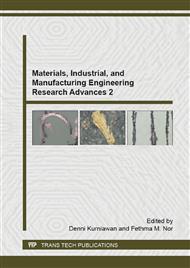[1]
Z. Awang, Research Methodology and Data Analysis, second ed., Penerbit Press Universiti Teknologi MARA, Malaysia, (2012).
Google Scholar
[2]
N. Zakuan, M.Z. Mat Saman, A.R. Hemdi, Critical success factors of green design implementation for malaysia automotive industry, Advanced Materials Research Vols. 383-390 (2012) pp.3395-3402.
DOI: 10.4028/www.scientific.net/amr.383-390.3395
Google Scholar
[3]
K. Li Wei, M.Z. Mat Saman, L. Meng Chiao, Development of green design framework for Malaysian automotive industries, Automotive Industry Conference (2008) Kuala Lumpur.
Google Scholar
[4]
A. Diabata, K. Govindan, An analysis of the drivers affecting the implementation of green supply chain management, Resources, Conservation and Recycling 55 (2011) 659–667.
DOI: 10.1016/j.resconrec.2010.12.002
Google Scholar
[5]
K. Govindan, D. Kannan, M. Shankar, Evaluation of green manufacturing practices using a hybrid MCDM model combining DANP with PROMETHEE, International Journal of Production Research (2014).
DOI: 10.1080/00207543.2014.898865
Google Scholar
[6]
T. Al Khidir, S.H. Mohamad Zailani, Going green in supply chain towards environmental sustainability, Global Journal of Environmental Research 3 (3) (2009) 246-251.
Google Scholar
[7]
T. Al Khidir, S.H. Mohamad Zailani, Greening of the supply chain through supply chain initiatives towards environmental sustainability.
Google Scholar
[8]
D.A. Wahab, Z.F. Fadzil, Public Community knowledge on reuse of end-of-life vehicles: a case study in an automotive industrial city in Malaysia, Journal of Applied Sciences 14 (3) (2014) 212-220.
DOI: 10.3923/jas.2014.212.220
Google Scholar
[9]
A.R. Anuar, M, Mohd. Mustafa, S.B. Rawi, M.Z. Mat Saman, S. Sharif, A comprehensive study for presentation as a response on the National Automotive Policy to the government, (2011).
Google Scholar
[10]
L. Amelia, D.A. Wahab, C.H. Che Haron, N. Muhamad, C.H. Azhari, Initiating automotive component reuse in Malaysia, Journal of Cleaner Production 17 (2009) 1572–1579.
DOI: 10.1016/j.jclepro.2009.06.011
Google Scholar
[11]
M.Z. Mat Saman, N. Zakuan, End-of-life vehicle directive: A key element to the vehicle design process (2006).
Google Scholar
[12]
A.H. Hu, C.W. Hsu, Critical factors for implementing green supply chain management practice, Management Research Review Vol. 33 Issue 6 (2010) p.586 – 608.
DOI: 10.1108/01409171011050208
Google Scholar
[13]
N.M. Yusop, D.A. Wahab, N. Saibani, Remanufacturing implementation in the Malaysian automotive industry; an overview. (2013).
Google Scholar
[14]
E.U. Olugu, K.Y. Wong, A.M. Shaharoun, Development of key performance measures for the automobile green supply chain, Resources, Conservation and Recycling 55 (2011) 567–579.
DOI: 10.1016/j.resconrec.2010.06.003
Google Scholar
[15]
M. Azmi, M.Z. Mat Saman, S. Sharif, N. Zakuan, S. Mahmood, Proposed framework for end-of-life vehicle recycling system implementation in Malaysia. Proceedings of the 11th Global Conference on Sustainable Manufacturing – Innovative Solutions, Berlin, Germany, 23-25 September (2013).
Google Scholar
[16]
S.P. Chuang, C.L. Yang, Key success factors when implementing a green manufacturing system, Production Planning & Control: The Management of Operations, 25: 11 (2014) 923-937.
DOI: 10.1080/09537287.2013.780314
Google Scholar
[17]
A.A. Lashlem, D.A. Wahab, S. Abdullah, C.H. Che Haron, A review on end-of-life vehicle design process and management. Journal of Applied Science 13 (5) (2013) 654-662.
DOI: 10.3923/jas.2013.654.662
Google Scholar
[18]
L.P.G. López, The treatment of end-of-life vehicles in Spain and the trend over time, Year 31 No. 123, Seguridad y Medio Ambiente, Spain, (2011).
Google Scholar
[19]
T.K. Eltayeba, S. Zailani, T. Ramayah, Green supply chain initiatives among certified companies in Malaysia and environmental sustainability: Investigating the outcomes, Resources, Conservation and Recycling 55 (2011) 495–506.
DOI: 10.1016/j.resconrec.2010.09.003
Google Scholar
[20]
C.C. Chena, H.S. Shih, H.J. Shyur, K.S. Wu, A business strategy selection of green supply chain management via an Analytic Network Process, Computers and Mathematics with Applications 64 (2012) 2544–2557.
DOI: 10.1016/j.camwa.2012.06.013
Google Scholar
[21]
Information on http: /data. worldbank. org/indicator/IS. VEH. NVEH. P3 accessed on 17 November (2014).
Google Scholar


